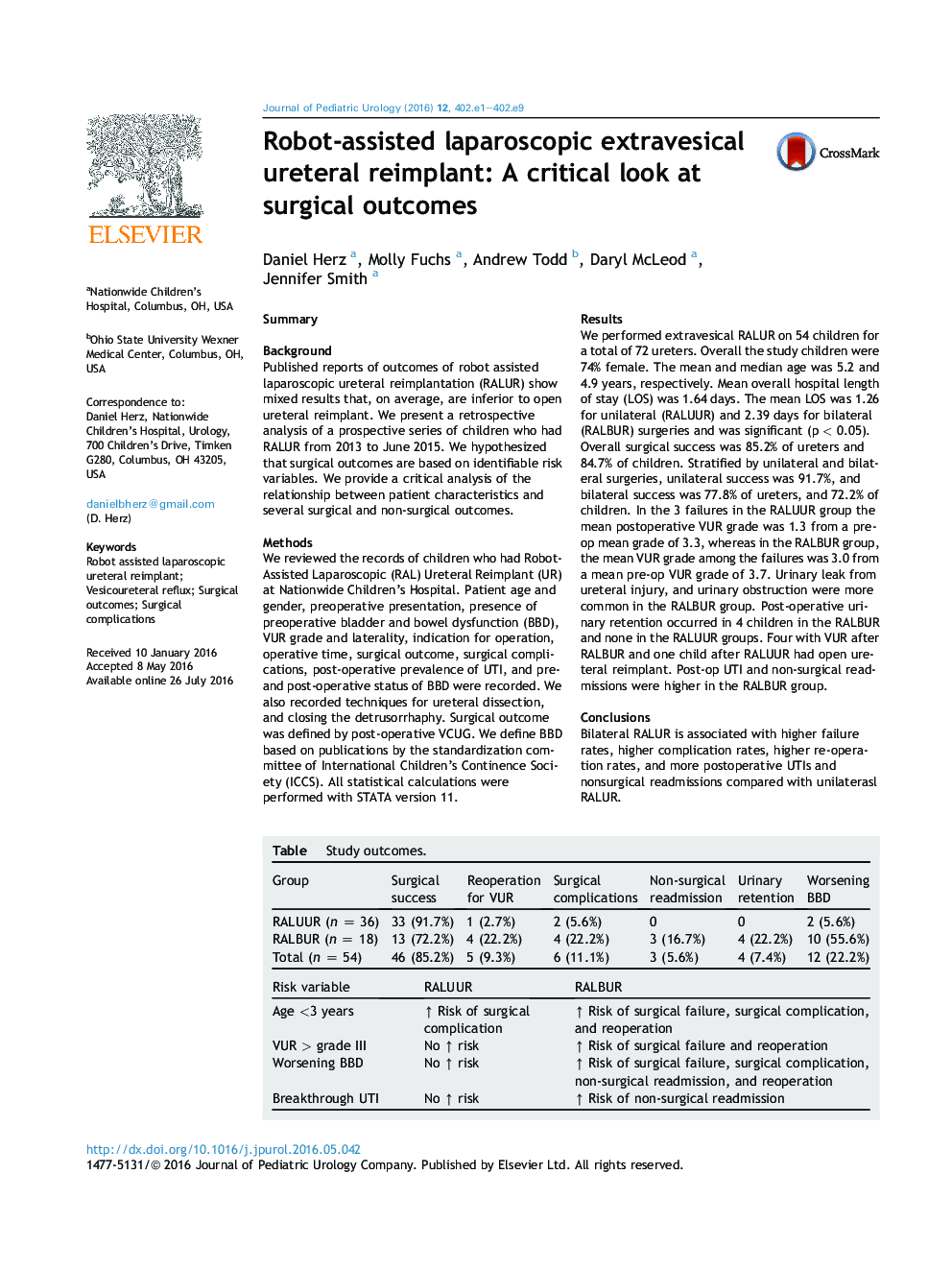| Article ID | Journal | Published Year | Pages | File Type |
|---|---|---|---|---|
| 5718726 | Journal of Pediatric Urology | 2016 | 9 Pages |
SummaryBackgroundPublished reports of outcomes of robot assisted laparoscopic ureteral reimplantation (RALUR) show mixed results that, on average, are inferior to open ureteral reimplant. We present a retrospective analysis of a prospective series of children who had RALUR from 2013 to June 2015. We hypothesized that surgical outcomes are based on identifiable risk variables. We provide a critical analysis of the relationship between patient characteristics and several surgical and non-surgical outcomes.MethodsWe reviewed the records of children who had Robot-Assisted Laparoscopic (RAL) Ureteral Reimplant (UR) at Nationwide Children's Hospital. Patient age and gender, preoperative presentation, presence of preoperative bladder and bowel dysfunction (BBD), VUR grade and laterality, indication for operation, operative time, surgical outcome, surgical complications, post-operative prevalence of UTI, and pre- and post-operative status of BBD were recorded. We also recorded techniques for ureteral dissection, and closing the detrusorrhaphy. Surgical outcome was defined by post-operative VCUG. We define BBD based on publications by the standardization committee of International Children's Continence Society (ICCS). All statistical calculations were performed with STATA version 11.ResultsWe performed extravesical RALUR on 54 children for a total of 72 ureters. Overall the study children were 74% female. The mean and median age was 5.2 and 4.9 years, respectively. Mean overall hospital length of stay (LOS) was 1.64 days. The mean LOS was 1.26 for unilateral (RALUUR) and 2.39 days for bilateral (RALBUR) surgeries and was significant (p < 0.05). Overall surgical success was 85.2% of ureters and 84.7% of children. Stratified by unilateral and bilateral surgeries, unilateral success was 91.7%, and bilateral success was 77.8% of ureters, and 72.2% of children. In the 3 failures in the RALUUR group the mean postoperative VUR grade was 1.3 from a pre-op mean grade of 3.3, whereas in the RALBUR group, the mean VUR grade among the failures was 3.0 from a mean pre-op VUR grade of 3.7. Urinary leak from ureteral injury, and urinary obstruction were more common in the RALBUR group. Post-operative urinary retention occurred in 4 children in the RALBUR and none in the RALUUR groups. Four with VUR after RALBUR and one child after RALUUR had open ureteral reimplant. Post-op UTI and non-surgical readmissions were higher in the RALBUR group.ConclusionsBilateral RALUR is associated with higher failure rates, higher complication rates, higher re-operation rates, and more postoperative UTIs and nonsurgical readmissions compared with unilaterasl RALUR. Table. Study outcomes.GroupSurgical successReoperation for VURSurgical complicationsNon-surgical readmissionUrinary retentionWorsening BBDRALUUR (n = 36)33 (91.7%)1 (2.7%)2 (5.6%)002 (5.6%)RALBUR (n = 18)13 (72.2%)4 (22.2%)4 (22.2%)3 (16.7%)4 (22.2%)10 (55.6%)Total (n = 54)46 (85.2%)5 (9.3%)6 (11.1%)3 (5.6%)4 (7.4%)12 (22.2%)Risk variableRALUURRALBURAge <3 yearsâ Risk of surgical complicationâ Risk of surgical failure, surgical complication, and reoperationVUR > grade IIINo â riskâ Risk of surgical failure and reoperationWorsening BBDNo â riskâ Risk of surgical failure, surgical complication, non-surgical readmission, and reoperationBreakthrough UTINo â riskâ Risk of non-surgical readmission
